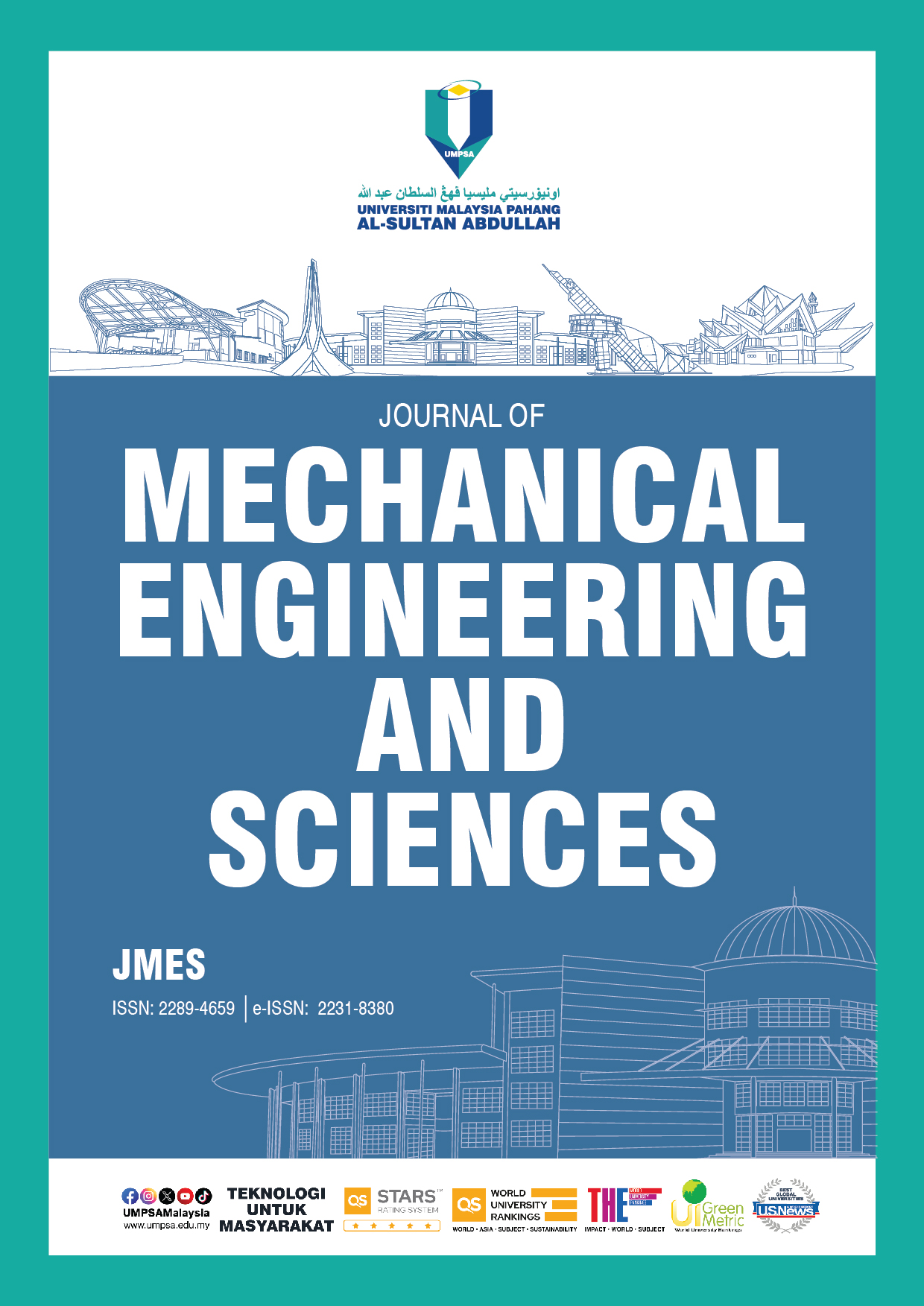A parametric study of insertion and retention forces in cantilever hook
DOI:
https://doi.org/10.15282/jmes.17.1.2023.6.0740Keywords:
Snap-Fit Joint, Finite Element Method, Retention Forces, Insertion ForcesAbstract
Adhesive bonding, mechanical fastening, and snap-fit are all ways for attaching plastic components together. Snap-fit is employed to assemble plastic parts because it is an efficient, cost-effective, and fast joining technique. When it comes to snap-fits, you have two options: separable and inseparable. The term separable refers to the ability of the components to be dismantled successfully without breaking, whereas inseparable refers to the plastic parts being permanently attached. This investigation focuses on cantilever snap-fit since it is frequently used in the automotive, aerospace, and other sectors. Numerous aspects and parameters affect the functioning of snap-fits, notably on the forces of the insertion and retention. The parameters are the feature thickness (Tb), beam length (Lb), beam width (Wb), base radius (Rb), mounting (α) and dismounting angle (β). The forces required to attach and detach the snap-fits are thought to increase as the insertion and retention angles increase. The results can be seen that higher insertion and retention angle contributes to higher insertion and retention forces as portrayed from Set 7 with the value of 1.1052 N and -1.0214 N.
References
M. S. Dolah and A. R. A. Rahman, “Design for assembly understanding to improve Malaysian office’s furniture assembly ergonomically,” Malaysian Journals of Public Health Medicine, vol. 5, 2005.
H. Salmanzadeh and M. Rasouli, “The influence of effective factors on mechanical stress on fingertips during snap-fit assembly,” Iranian Rehabilitation Journal, vol. 13, no. 3, pp. 38 –47, 2015.
K. Torossian and D. Bourell, “Experimental Study of Snap-Fits Using Additive Manufacturing,” 26thAnnualInternational Solid Freeform Fabrication Symposium, Texas, 2015.
S. Genc, R. W. Messier, and G. A. Gabriele, “A systematic approach to integral snap-fit attachment design,” Research in Engineering Design, vol. 10, pp. 84–93, 1998.
P. Golewski and T. Sadowski, “Numerical analysis of two types polymeric fibre composite materials with different reinforcement architecture for creation of innovative snap-fit joints,” Materials Science and Engineering, vol. 416, no. 1, p. 012061, 2018.
G. Suri and A. F. Luscher, “Evaluation metrics for the rating and optimization of snap-fits,” Research in Engineering Design -Theory, Applications, and Concurrent Engineering, vol. 12, no. 4, pp. 191–203, 2000.
K. Yoshida and H. Wada, “Mechanics of a snap fit,” Physical Review Letters, vol. 125, no. 19, p. 194301, 2020.[8]Snap-fit design manual, BASF Corporation Engineering Plastic, 2007. Available: https://studylib.net/doc/18095696/basf-snap fit-design-manual (accessed March, 2023).
Y. H. Chen and C. C. Lan, “Design of a constant-force snap-fit mechanism for minimal mating uncertainty,” Mechanism and Machine Theory, vol. 55, pp. 34–50, 2012.
H. S. Kakade and V. G. Patil, “Design optimization of snap fit feature of lock plate to reduce its installation force by using DOE methodology,” International Research Journal of Engineering and Technology, vol. 6, no. 6, p. 2994, 2008.
J. Ji, K. M. Lee, and S. Zhang, “Cantilever snap-fit performance analysis for haptic evaluation,” Journal of Mechanical Design, Transactions of the ASME, vol. 133, no. 12, p. 121004, 2011.
R. Kumar, R. R. Poojari, and A. Kumar Choudhary, “Design and analysis of snap fit joint,” International Journal of Interdisciplinary Innovative Research & Development, vol. 2, no. 3, pp. 105 –109, 2017.
B. He, H. Li, and K. Jin, “Shape memory polymer actuated hollow snap-fit design analysis,” Materials & Design,vol.47, pp. 539–550, 2013.[
E. Whalen and R. Kodwani, “Snap-Fit Optimization for Achieving Desired Insertion and Retention Forces,” Altair Engineering Inc. USA.
S. S. Suzamri and M. N. Osman Zahid, “Insertion force in snap-fits assembly based on different design parameters: A simulation study,” Lecture Notes in Mechanical Engineering, vol. 46, pp. 991–999, 2021.
G. Suri, “A fundamental investigation of retention phenomena in snap-fit features,” PhD Dissertation, The Ohio State University, 2002.
P. R. Bonenberger, “The first snap-fit handbook,” Carl Hanser Verlag, Munich, 2016.
J. L. Amaya, E. A. Ramírez, F. Maldonado Galarza, and J. Hurel, “Detailed design process and assemblyconsiderations for snap-fit joints using additive manufacturing,” Procedia CIRP, vol. 84, pp. 680–687, 2019.
T. Ruan, “Selection and optimization of snap-fit features via web-based software,” PhD Dissertation, The Ohio State University, 2005.
P. Ajesh, A. Bhadalkar, R. Warghane, and S. Deokar, “Design and analysis of snap fit joint with design calculator,” International Conference on Ideas, Impact and Innovation in Mechanical Engineering,vol. 5, no. 6, pp. 644 –649, 2017.
Downloads
Published
Issue
Section
License
Copyright (c) 2023 Universiti Malaysia Pahang Publishing

This work is licensed under a Creative Commons Attribution 4.0 International License.






